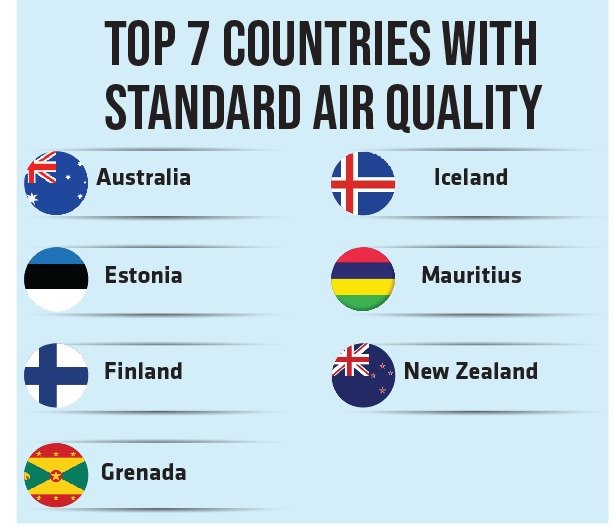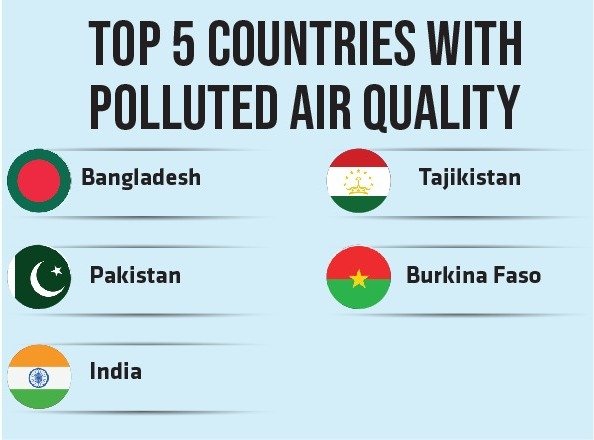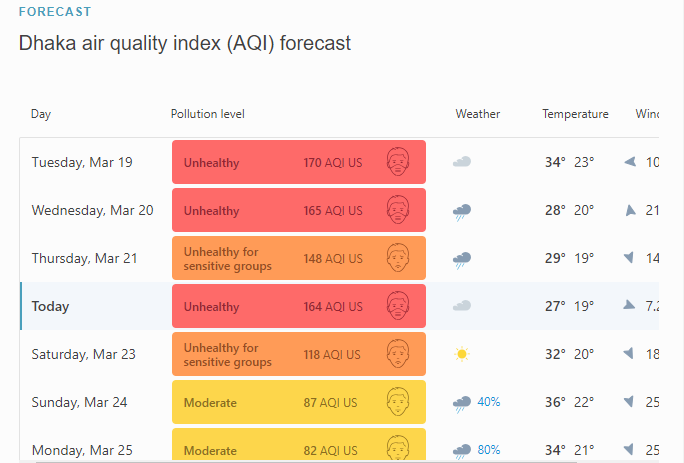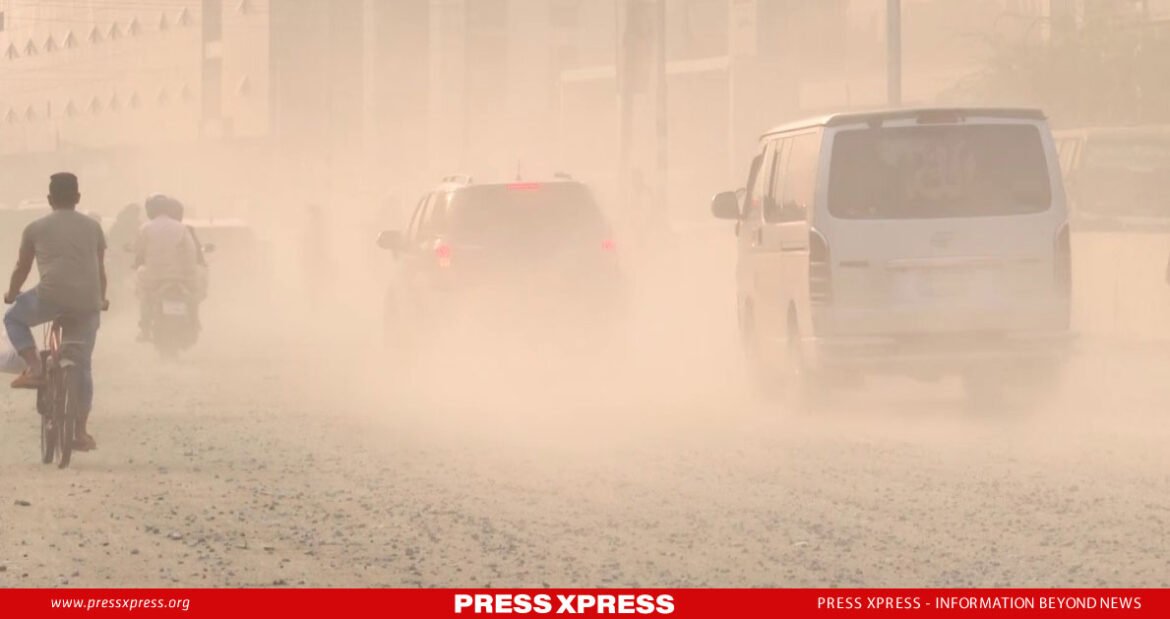The current PM2.5 (particulate matter) concentration in Dhaka exceeds the WHO annual air quality guideline value by 19.3 times, indicating a highly unhealthy level. Urban areas across Bangladesh grapple with elevated levels of particulate matter in the air, particularly during the dry season (November – April). This period witnesses minimal rainfall, prevailing northwesterly winds, and decreased relative humidity, exacerbating air quality concerns.
You Can Also Read: How Tobacco Cultivation is Eroding Bangladesh’s Environment?
WHO’s Standard Air Quality Guidelines are comprehensive recommendations aimed at reducing the health risks associated with exposure to air pollutants. These guidelines provide thresholds for key pollutants such as particulate matter (PM2.5 and PM10), ozone (O3), nitrogen dioxide (NO2), sulfur dioxide (SO2), and carbon monoxide (CO). By setting these standards, WHO aims to guide policymakers, environmental agencies, and governments in implementing measures to improve air quality and protect public health.
Air pollution is a pressing global issue that affects the health and well-being of millions worldwide. According to the World Health Organization (WHO), 9 out of 10 people breathe polluted air around the world, leading to various health problems ranging from respiratory diseases to cardiovascular issues. In response to this alarming trend, WHO has established standard air quality guidelines to safeguard public health and mitigate the adverse effects of air pollution.
WHO’s New Air Quality Guidelines
The new air quality guidelines (WHO AQG) are ambitious and reflect the large impact that air pollution has on global health. They recommend aiming for annual mean concentrations of PM2.5 not exceeding 5 µg/m³ NO2 not exceeding 10 µg/m³, and the peak season mean 8-hr ozone concentration not exceeding 60 µg/m34. By striving to achieve these guideline levels, countries will be both protecting health as well as mitigating global climate change.
Implications and Importance
Adhering to WHO’s Standard Air Quality Guidelines is crucial for safeguarding public health and reducing the burden of air pollution-related diseases. By implementing measures such as reducing emissions from vehicles and industrial sources, promoting clean energy alternatives, and enhancing urban planning, governments can work towards achieving these guidelines and ensuring clean and healthy air for all.
Top Polluted and Safest Air Qualities of Different Countries
WHO’s Standard Air Quality Guidelines serve as a vital tool in addressing the global challenge of air pollution. By setting clear thresholds for key pollutants and providing guidance to policymakers and governments, these guidelines play a crucial role in protecting public health and promoting sustainable development. Countries must prioritize efforts to improve air quality and adhere to these guidelines to create a healthier and more sustainable future for generations to come.
In 2023, a comprehensive analysis of air quality data from over 30,000 stations and sensors across 7,323 cities in 131 countries, regions, and territories was collected. This analysis was done in collaboration with organizations like the United Nations Environmental Program, UN-Habitat, and Greenpeace to address the issue of air pollution.

From these 131 countries, regions, and territories only 13 countries were marked to have normal air quality, and only 7 were marked as having standard air quality.

Concern for Bangladesh
Air quality in Bangladesh is a significant concern, especially when compared to the WHO’s air quality standards. The WHO’s air quality guidelines recommend a limit value for specific air pollutants to protect public health. One of these pollutants is PM2.5 (particulate matter less than 2.5 micrometers in diameter), for which the WHO’s acceptable standard is 5 µg/m³.
However, in many cities in Bangladesh, PM2.5 concentrations are anywhere from 6 to 16 times the WHO’s safety guidelines. This means that every resident of Bangladesh currently lives in a region where PM2.5 pollution levels greatly exceed the WHO’s acceptable standard.
This level of air pollution has serious health implications. For instance, fine particulate air pollution (PM2.5) shortens the average Bangladeshi resident’s life expectancy by 6.8 years, relative to what it would be if the WHO guideline of 5 µg/m³ was met.
Therefore, improving air quality to meet WHO standards is a critical issue for Bangladesh. It requires concerted efforts in monitoring, regulation, and public awareness to address this environmental health challenge.

Challenges for Bangladesh
Bangladesh faces several challenges in recovering the air pollution standard set by the WHO. Some of the key challenges are-
- High Levels of Pollution: The concentrations of fine particulate matter (PM2.5) in some of the region’s most densely populated and poor areas are up to 16 to 20 times higher than the WHO standard. This extreme air pollution has impacts ranging from stunting and reduced cognitive development in children, to respiratory infections and chronic and debilitating diseases.
- Transboundary Pollution: Air pollution travels long distances, crosses national boundaries, and gets trapped in large “airsheds” shaped by climatology and geography. In many cities, such as Dhaka, only one-third of the air pollution originates within the city.
- Health Hazards: Exposure to high levels of air pollution significantly raises the risks of breathing difficulties, cough, lower respiratory tract infections, as well as depression, and other health conditions.
- Economic Costs: Air pollution drives healthcare costs, lowers a country’s productive capacity, and leads to lost work days.
- Lack of awareness and understanding: The general population lacks awareness about the health impacts of poor air quality. Many people are not aware of the sources of pollution or how it affects their health.
- Inadequate monitoring infrastructure: Bangladesh has limited resources for monitoring air quality across the country. There are only a few monitoring stations in major cities, and data collection is inconsistent.
- Insufficient regulations and enforcement: While there are some regulations to control air pollution in Bangladesh, their enforcement is often weak due to limited resources and corruption issues.
- Dependence on fossil fuels: The country heavily relies on fossil fuels for energy production, which leads to high levels of emissions contributing to poor air quality.
- Agricultural practices: Agricultural activities such as crop burning contribute significantly to air pollution during certain seasons in rural areas.
- Climate change impacts: Bangladesh is vulnerable to climate change impacts such as increased frequency and intensity of natural disasters like cyclones and floods, which can worsen air quality through increased dust storms or releases from damaged industries or infrastructure.
Sustainable Measures to Improve the Air Quality of Dhaka City
The government and environmental advocates are collaborating to devise and enact sustainable strategies aimed at enhancing Dhaka city’s air quality. Proposed solutions encompass:
Public Transportation Promotion: Encouraging the utilization of buses, trains, and rickshaws to diminish vehicular volume on roads, thereby reducing emissions and traffic congestion.
Green Technology Adoption: Encouraging industries to embrace eco-friendly practices and technologies to minimize emissions, including investments in cleaner energy sources like solar power.
Stringent Emission Standards: Enforcing rigorous emission standards for vehicles and industries, alongside regular monitoring and penalties for non-compliance.
Green Space Promotion: Establishment and preservation of green areas within the city to serve as natural air purifiers by absorbing pollutants.
Public Awareness Campaigns: Launching extensive campaigns to educate citizens on the perils of air pollution and the significance of individual actions in mitigating it.
Waste Management Reforms: Implementing effective waste management practices to discourage waste burning and promote recycling.
Acknowledging the severity of the air pollution crisis, the Bangladeshi government has established a task force within the Ministry of Environment and Forests to formulate comprehensive plans to combat air pollution in Dhaka. Collaboration with international bodies and seeking foreign aid for large-scale sustainable development projects is also underway.
Despite the promising nature of these proposed measures, challenges lie ahead. Economic limitations, rapid urbanization, and industrial expansion may impede swift implementation. Overcoming cultural and behavioral barriers to adopting cleaner practices will necessitate collective effort and cooperation from all stakeholders.
The urgent nature of Dhaka city’s air quality situation underscores the need for immediate attention and action. By prioritizing sustainable solutions, enforcing stricter regulations, and fostering public awareness, it is hoped that Dhaka’s residents will enjoy cleaner air and improved health. Achieving a greener and healthier future for Dhaka requires concerted efforts from individuals and policymakers alike.
Conclusion
The World Bank supports Bangladesh through analytical work & investments toward effective strategies combating its severe AQ issues where collaboration with international partners plays an important role too. Global efforts must continue evolving through research advancements & deeper understanding regarding the effects resulting from increasing pollutants; this will ensure the highest level of protection worldwide while maintaining sustainable development goals implementing these measures and collaborating with international partners, Bangladesh can make significant progress in improving its air quality standards.
The WHO’s air quality guidelines and standards are crucial tools for countries to monitor and improve their air quality, thereby protecting public health and mitigating climate change. As research advances and our understanding of the health effects of air pollution deepens, these guidelines will continue to evolve to ensure the highest level of protection for people worldwide.


